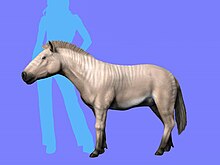Hipparion
| Hipparion Temporal range: Late Miocene
| |
|---|---|

| |
| H. laromae skeleton | |
| Scientific classification | |
| Domain: | Eukaryota |
| Kingdom: | Animalia |
| Phylum: | Chordata |
| Class: | Mammalia |
| Order: | Perissodactyla |
| Family: | Equidae |
| Subfamily: | Equinae |
| Tribe: | †Hipparionini |
| Genus: | †Hipparion De Christol, 1832 |
| Species | |
|
See text | |
| Synonyms | |
| |
Hipparion is an
Taxonomy
"Hipparion" in sensu lato
The genus "Hipparion" was used for over a century as a
Hipparion in sensu stricto
Hipparion in
Morphology



Limbs
Hipparion generally resembled a smaller version of the
Size
Hipparion was typically medium in size, at about 1.4 m (4.6 ft) tall at the shoulder.[7][8] The estimated body mass of Hipparion depends on the species, but ranges from about 135 to 200 kg (about 298 to 441 lbs).[2]
Skull
Hipparion had
Life
Habitat and diet
Hipparion lived in the Old World Savannah
Lifespan
Hipparion achieved skeletal maturity and possibly sexual maturity at about 3 years old. Fossils of Hipparion individuals have been found to be up to 10 years old at the time of death.[8]
Evolution and extinction
Evolution
Hipparion likely evolved from a species of Cormohipparion during the Late Miocene, about 11.4-11.0 Ma. This species, C. occidentale, came to Eurasia and Africa from North America.[2] The last common ancestor of Hipparion and the modern horse was Merychippus.[11]
Extinction
In the Old World, Hipparion experienced population decline and extinction down a North to South gradient, as did many other Miocene vertebrates. This trend is believed to be due to environmental changes caused by global cooling and decreasing carbon dioxide levels in the atmosphere.[4]
Species
- H. chiai Liu et al., 1978
- H. concudense Pirlot, 1956
- H. condoni Merrian, 1915
- H. crassum Gervais, 1859
- H. dietrichi Wehrli, 1941
- H. fissurae Crusafont and Sondaar, 1971
- H. forcei Richey, 1948
- H. gromovae Villalta and Crusafont, 1957
- H. laromae Pesquero et al., 2006
- H. longipes Gromova, 1952
- H. lufengense Sun, 2013
- H. macedonicum Koufos, 1984
- H. matthewi Abel, 1926
- H. mediterraneum Roth and Wagner, 1855
- H. molayanense Zouhri, 1992
- H. minus Pavlow, 1890
- H. periafricanum Villalta and Crusafont, 1957
- H. philippus Koufos & Vlachou, 2016
- H. phlegrae Lazaridis and Tsoukala, 2014
- H. prostylum Gervais, 1849 (type)
- H. rocinantis Pacheco, 1921
- H. sellardsi Matthew and Stirton, 1930
- H. shirleyae MacFadden, 1984
- H. sithonis Koufos & Vlachou, 2016
- H. sitifense Pomel, 1897
- H. tchicoicum Ivanjev, 1966[12]
- H. tehonense (Merriam, 1916)
- H. theniusi Melentis, 1969
- H. venustum Leidy, 1860
References
- ISSN 0277-3791.
- ^ .
- ^ – via JSTOR.
- ^ – via Schweizerbart Science Publishers.
- ^ MacFadden, Bruce J. (August 1980). "The Miocene horse Hipparion from North America and from the type locality in Southern France". Paleontology. 23 (3): 617–635 – via The Paleontological Association.
- ISBN 9781443417860.
- ISBN 1-84028-152-9.
- ^ PMID 25098950.
- ISSN 0272-4634.
- ISBN 0-716-71822-7.
- PMID 28183978.
- PMID 37186049.
